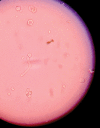Microbiological Evaluation of Herbal Extracts against Candida albicans in Early Childhood Caries Patients: An In Vitro Study
- PMID: 38559866
- PMCID: PMC10978517
- DOI: 10.5005/jp-journals-10005-2733
Microbiological Evaluation of Herbal Extracts against Candida albicans in Early Childhood Caries Patients: An In Vitro Study
Abstract
Purpose: The current literature proposes a probable role of Candida albicans (C. albicans) in its etiopathogenesis in early childhood caries (ECC). This study aimed to isolate C. albicans species in children with and without ECC and compare the antifungal efficacy of neem, miswak, cinnamon, clove, stevia, and ketoconazole. This study also aimed to assess and compare salivary pH in children with and without ECC.
Materials and methods: A total of 60 children were included in the study, who were divided into two groups-group I (children with ECC) and group II (children without ECC). Plaque samples were collected and streaked on Sabouraud dextrose agar (SDA). C. albicans isolates were evaluated, and their susceptibility to herbal agents was tested and compared. Saliva samples were collected, and salivary pH was tested and compared.
Results: The presence of C. albicans was significantly higher in group I (76.7%) as compared to group II (23.3%). The mean zone of inhibition for neem was 4.9 mm, whereas, for miswak, it was 4.5 mm; for cinnamon, 9.3 mm; for clove, 3.8 mm; for stevia, 10.9 mm; and for ketoconazole it was 21.09 mm. The mean salivary pH for group I was 6.7, and that for group II was 7.3.
Conclusion: Candida albicans (C. albicans) carriage in children with ECC was significantly higher than in children without ECC. All herbal agents showed significant antifungal activity, with stevia showing the highest activity. The average salivary pH of children without ECC was slightly higher than that of children with ECC.
How to cite this article: Siddaiah SB, Sinha S, BR A. Microbiological Evaluation of Herbal Extracts against Candida albicans in Early Childhood Caries Patients: An In Vitro Study. Int J Clin Pediatr Dent 2024;17(1):26-30.
Keywords: Candida albicans; Dental Caries; Early childhood caries; Herbal drugs; Salivary pH.
Copyright © 2024; The Author(s).
Conflict of interest statement
Source of support: Nil Conflict of interest: None
Figures
Similar articles
-
Comparative Assessment of Antimicrobial Activity of Propolis and Chlorhexidine on Salivary Isolates of Candida albicans and Streptococcus mutans in Children with Severe Early Childhood Caries: An In Vitro Study.Int J Clin Pediatr Dent. 2024 May;17(5):591-595. doi: 10.5005/jp-journals-10005-2875. Int J Clin Pediatr Dent. 2024. PMID: 39355192 Free PMC article.
-
Candida albicans Carriage in Children with Severe Early Childhood Caries (S-ECC) and Maternal Relatedness.PLoS One. 2016 Oct 14;11(10):e0164242. doi: 10.1371/journal.pone.0164242. eCollection 2016. PLoS One. 2016. PMID: 27741258 Free PMC article.
-
Presence of candida in the dental plaque and saliva of patients with severe early childhood caries and early childhood caries:a pilot study.Eur Oral Res. 2024 May 5;58(2):102-107. doi: 10.26650/eor.20241067980. Eur Oral Res. 2024. PMID: 39011175 Free PMC article.
-
Candida albicans and Early Childhood Caries: A Systematic Review and Meta-Analysis.Caries Res. 2018;52(1-2):102-112. doi: 10.1159/000481833. Epub 2017 Dec 21. Caries Res. 2018. PMID: 29262404 Free PMC article.
-
Oral Candida-biome and Early Childhood Caries: A Systematic Review and Meta-Analysis.Int Dent J. 2025 Apr;75(2):1246-1260. doi: 10.1016/j.identj.2024.08.020. Epub 2024 Sep 24. Int Dent J. 2025. PMID: 39322518 Free PMC article.
Cited by
-
Investigating the association between Candida albicans and early childhood dental caries: A comprehensive systematic review and meta-analysis.PLoS One. 2024 Dec 16;19(12):e0315086. doi: 10.1371/journal.pone.0315086. eCollection 2024. PLoS One. 2024. PMID: 39680595 Free PMC article.
References
-
- Maheshwaran B, Priyadharshini R, Kumar S, et al. Antimicrobial activity and cytotoxicity of mouthwash prepared from Azadirachta indica and Stevia rebaudiana extract– an in vitro study. J Pharmaceut Res Int. 2021;33(59B):96–107. doi: 10.9734/jpri/2021/v33i59b34357. - DOI
LinkOut - more resources
Full Text Sources


